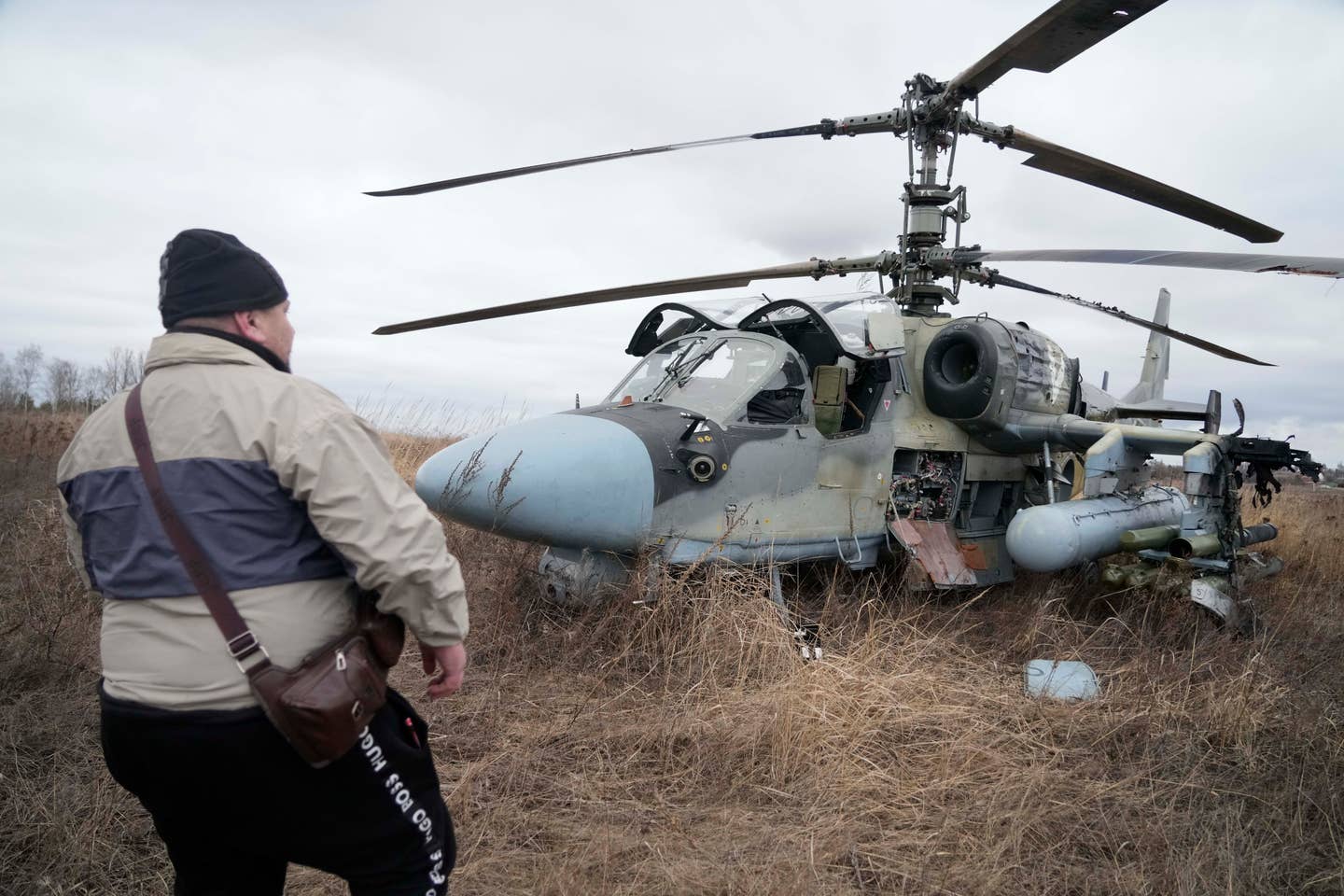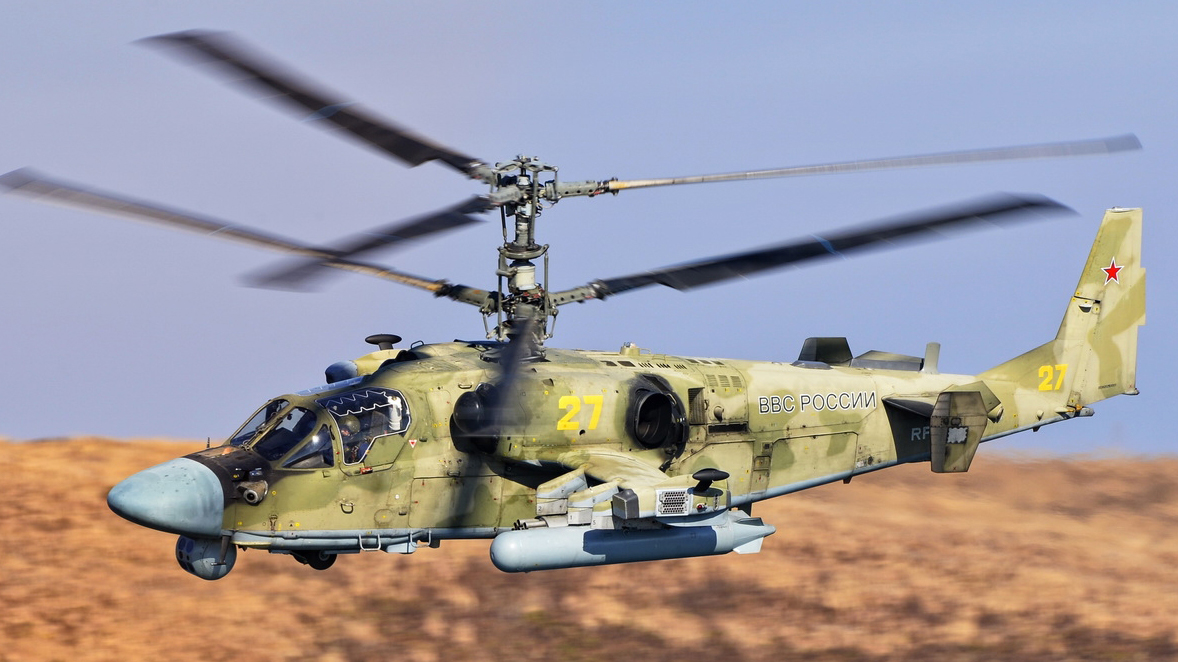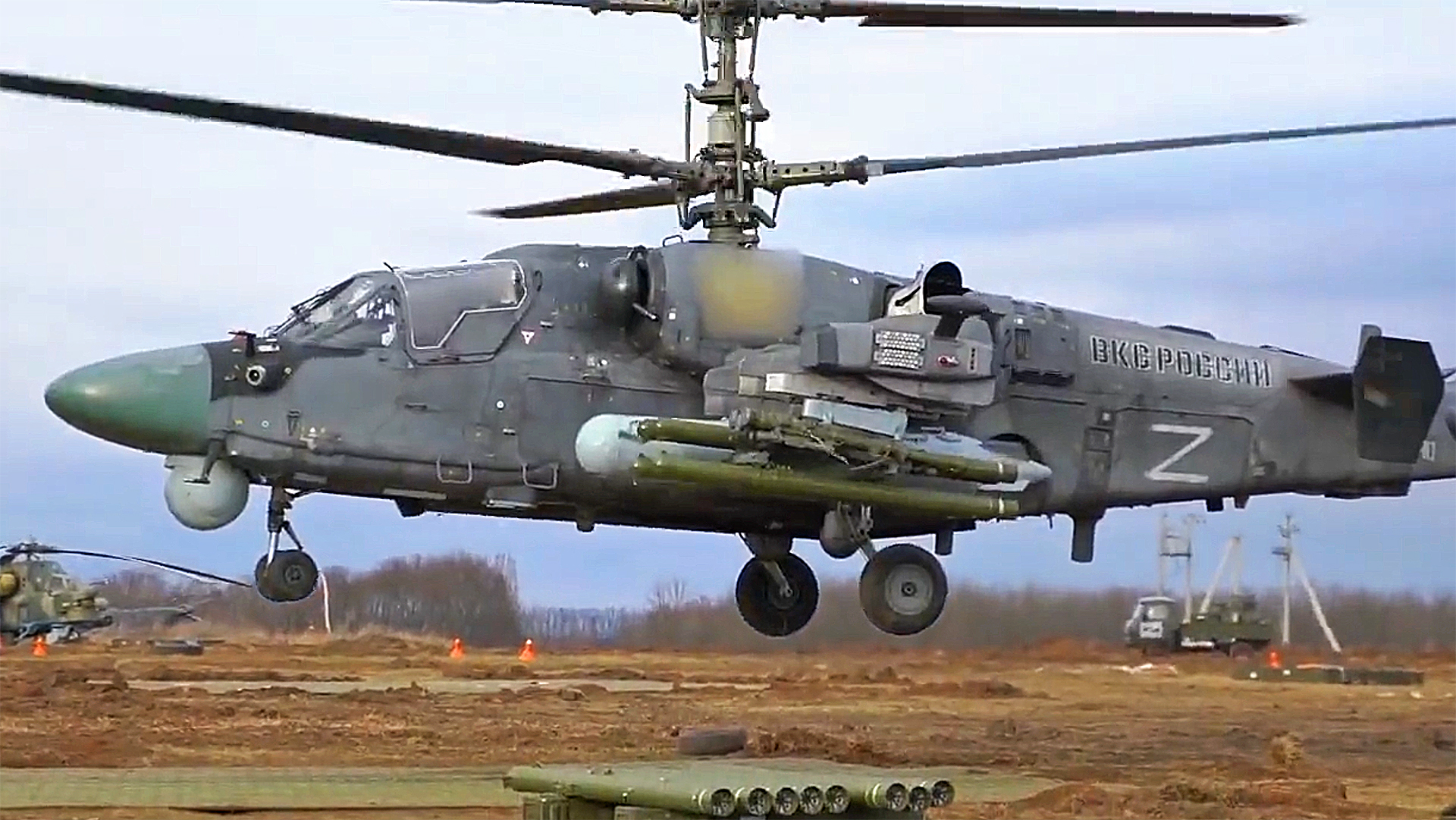Russian Ka-52 Hokum attack helicopters fighting in the war in Ukraine are suffering from a major vibration issue that could, according to at least one expert The War Zone consulted, decrease reliability and, potentially, be unsafe. At best, according to assessments we’ve received, the vibration is likely to reduce the efficiency of the weapons these helicopters carry, and may also restrict weapon life. In turn, this could have an effect on the capability of the Ka-52, one of the most widely used Russian helicopters of the conflict so far.
Video clips showing Ka-52s operating with their stub wings rapidly bouncing up and down began to appear on social media in recent weeks and there has already been speculation that the issue could lead to “mechanical failures and vibration-induced fatigue.”
Until now, however, there has been a lack of expert input on this matter, which The War Zone has addressed by talking to four experts in the field. Three of those have chosen to remain anonymous since they are either still serving or otherwise work on behalf of the military in their respective countries.
The two-seat Ka-52 is an attack helicopter with an unconventional coaxial main rotor arrangement, obviating the need for a tail rotor. It’s fitted with a two-spar stub wing on each side of the fuselage. These ‘wings’ have no high-lift devices; they serve exclusively to carry armament and other stores, as well as sensors and flare dispensers at the tips.

The videos showing vibrating stub wings on Ka-52s involved in the Ukrainian campaign include helicopters cruising in level flight, on the approach, and landing vertically. In each case, the stub wings are fitted with heavy loads combining fuel tanks, anti-tank guided missiles (ATGMs), anti-aircraft missiles, and pods for unguided rockets. In fact, videos showing such heavily laden Ka-52s are hard to find before the war in Ukraine, suggesting overall stores weight may play a role here.
First off, we spoke to an aeronautical engineer whose professional experience includes heading up the future projects division of a major helicopter manufacturer.
He quickly identified the vibration issue as “vertical bounce at (maybe) blade passing frequency.”
Ultimately, a helicopter rotor acts like a kind of vibration filter, with the main variation in load that gets passed down the rotor shaft being a vertical input that varies according to the blade passing frequency.
Blade passing frequency differs from helicopter to helicopter, based on the number of rotor blades. A Bell 47 or a JetRanger, for example, has a vertical load component of two per revolution, as each has a pair of rotor blades. For a five-bladed S-61 Sea King, by contrast, the largest single component of vibration would be at the blade passing frequency of five per revolution.
As for the Ka-52, this has two three-bladed rotors and each of these assemblies will produce the largest single component of vibration at a blade passing frequency of three per rev. As the two rotor assemblies turn in opposite directions, it’s conceivable that some loads will be reduced, and others reinforced as a result.

Regardless, the main thing to consider is whether there is anything in the stub wing and stores pylon structure with a natural frequency that, in a particular vibration mode, coincides with the main vibratory load frequency coming from the rotors.
Were that the case, that part of the structure will be excited in that mode, “producing increased structural deflection and an adverse environment for the weapons being carried,” in the words of our engineering expert. “If, for example, the second mode of vertical bending of the wing had a natural frequency close to the blade passing frequency, then the wings could busily ‘flap away’ as a result.” Based on the videos we’ve seen, that would appear to be a highly probable conclusion.
Interestingly, the same expert told us that he’d watched a Kamov flight demonstration at the manufacturer’s Lyubertsy test center in the 1990s, but had not witnessed anything like this vibration issue.
He did, however, note that perhaps the most troubling feature of the vibration could be its effect on the missile armament carried.
“Typical issues would be ability of missile infrared sensors (if used) to obtain lock-on (particularly if there are any components sensitive to that frequency).”
In each of the videos that appear on this page, the Ka-52s are indeed carrying missiles with infrared seekers, namely the 9M39 Igla-V weapons (air-launched versions of the familiar SA-18 Grouse man-portable air defense system), two of which are seen on each outer pylon. It appears that these air-to-air weapons only began to appear a few weeks into the conflict, reflecting the lack of Russian air superiority.
“The other issue might be weapon life — my recollection is that this sort of vibration environment would be detrimental to life.” Missiles, whether Igla-Vs or the ATGMs carried in clusters on the inboard pylons, are sensitive pieces of equipment and don’t take well to being buffeted or otherwise thrown around. Excessive vibration could well be passed on to the missile seeker, motor, warhead, or control systems, with detrimental results.
“It also looks as if, with this weapon load, there is a wing vertical response feeding into the weapon motion,” the same expert concluded. “All I can say is that it doesn’t look good.”

The next individual we spoke to is an ex-military rotary-wing pilot and a weapons test engineer with direct experience with stores trials involving military helicopters.
“This is clearly high-amplitude vibration and might shorten carriage life,” he told us, immediately identifying the potential for damage to the weapons being carried. This could mean the movements imparted by the vibrations exceed the limits imposed by the design authority, or simply that the stores being carried become progressively less reliable “and even unsafe in extreme cases.”
While that would apply to the missiles, it would potentially also affect the sensors carried on the tips of the stub wings, associated with the self-protection system. This, of course, is vital for the survival of the Ka-52s in what is increasingly contested airspace, with a proliferation of man-portable air defense systems (MANPADS), as well as other, less conventional weapons. While reliable figures are unavailable, it seems the Ka-52 has taken heavy losses so far, with firm evidence of at least 13 examples seriously damaged or destroyed, although which of these were lost to enemy fire, pilot error, or mechanical issues, is similarly unclear.
“I experienced the [vibration] problem, now many years ago, as a helicopter pilot, and then seeing colleagues work on helicopter carriage of weapons,” the weapons test engineer explained. “As you can imagine, the vibration pattern is a combination of harmonics of the natural frequencies of the main rotor(s), (and tail rotor for helicopters so fitted), and aero/structure reactions.”
Gun and rocket firing by Russian Ka-52s of the Eastern Military District in 2017. No vibration is evident on these (lightly loaded) helicopters:

Finally, we discussed the videos with a helicopter pilot currently serving, who has direct experience of trials involving the service clearance of weapons and stub wings.
“This looks like they haven’t even heard of damping,” he remarked. “My general understanding is that aside from any impact on accuracy it’s going to significantly reduce the life of the weapon. So rather than 100 air carriage hours it could be as few as 10 before the missile won’t work. All the shaking generally not being good for the electronics, or the explosives, which could become more sensitive.”
The same pilot noted that “we definitely wouldn’t clear something to operate if it was doing that,” before adding that he expects the effect might not only be felt by the weapons but also by the wing itself and the stores pylons.
An alternative theory to the vibration issue was provided by another experienced helicopter pilot, who goes by the Twitter handle @thenewarea51 . A commercial air ambulance pilot, they noted that this could also possibly be a track-and-balance issue with the rotors. This takes hours of time to do after maintenance on a regular helicopter, let alone a six-bladed contra-rotating configuration. It is dangerous to fly without it, but it isn’t clear just how hard Russia is pushing its helicopter fleet at this point in its invasion of Ukraine.
Live-fire training campaign involving Ka-52s armed with Vikhr-1 ATGMs. Again, no vibration is evident but the helicopters carry just two rocket pods and only two of the tube-launched ATGMs:

With the Ka-52 having been subject to evaluation by the Russian military since 2011, and already having seen combat service in Syria, it would seem unlikely that the vibration issue hasn’t been identified before.
With that in mind, it could the that the Russian Aerospace Forces and Kamov deemed that the problem was not severe enough to disrupt daily combat operations and that the possible effects on the weapons was judged a price willing to be paid. After all, if weapons are being expended on most sorties, then the effect on missile service life ceases to become such a big issue.
There is also the possibility that the Ka-52s being used in Ukraine are carrying heavier weapons loads than is usual. As noted, the aircraft exhibiting vibration all carry fairly big loads of stores, with the fuel tanks, in particular, adding significant weight, especially depending on how full they are. This factor, too, could affect the vibration levels.

It’s also worth bearing in mind that the issue may well be isolated to a portion of the fleet and, with only a few videos so far, we don’t have a real sense of how widespread this vibration issue could be. Perhaps, it afflicts only older-production helicopters, for example.
While the subject matter experts we spoke to all agreed that the vibration looked like it could be a problem, especially on sensitive weapons, it’s clear that the Ka-52 remains very much heavily engaged in the ongoing fighting. It will be interesting to see if any measures are taken to address the vibration, especially if it starts to take a toll on airframe as well as stores.
Contact the author: thomas@thedrive.com
